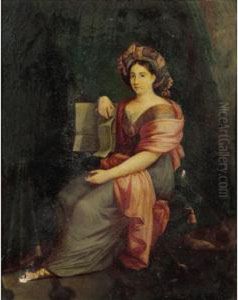Jacques Nicolas Paillot De Montabert Paintings
Jacques Nicolas Paillot de Montabert, born on April 14, 1771, in Troyes, France, was a notable figure in the arts, primarily recognized for his contributions as an art historian and writer rather than as an artist. His work was particularly influential in the early 19th century, a period marked by significant changes in artistic styles and the role of art in European society.
Paillot de Montabert's most significant contribution to art history is his extensive nine-volume treatise on painting techniques titled 'Traité complet de la peinture' (Complete Treatise on Painting), published between 1829 and 1851. This work, which was completed and published posthumously, is a detailed account of the technical and theoretical aspects of painting, encompassing a wide range of topics from the preparation of canvases and pigments to the philosophical principles behind artistic creation. The treatise was an invaluable resource for artists, providing them with a comprehensive guide to traditional painting methods as well as insights into the evolving techniques of the time.
Although Paillot de Montabert was not an artist of particular renown, his influence was felt through the education and instruction his writings provided. His emphasis on the mastery of classical techniques and the importance of historical knowledge in the creation of art resonated with contemporary artists and educators. He advocated for a structured and disciplined approach to art education, which was in line with the academic traditions of the period.
Despite his importance in the art historical sphere, there is relatively limited biographical information about Paillot de Montabert's life outside of his scholarly work. He lived through a tumultuous period in French history, which included the French Revolution, the rise and fall of Napoleon, and the restoration of the French monarchy. These events undoubtedly influenced the context in which he wrote and the reception of his ideas.
Jacques Nicolas Paillot de Montabert passed away on July 14, 1849, in Paris. His legacy is preserved through his written work, which continued to be a reference for artists and art historians well into the 19th century and beyond. Despite not being as widely known as some of his contemporaries, his dedication to the dissemination of artistic knowledge and his belief in the intellectual underpinnings of artistic practice have cemented his place in the history of art education.
